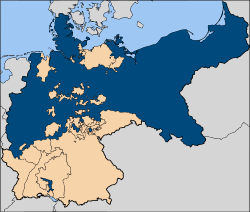Prussia (Àdàkọ:Audio-de ; Latin : Borussia , Prutenia ; Àdàkọ:Lang-lv ; Àdàkọ:Lang-lt ; Pólándì : [Prusy ] error: {{lang}}: text has italic markup (help ) ; Old Prussian : Prūsa )
Preußen
Flag (1892–1918)
Coat of arms (1701–1918)
Motto Suum cuique (Latin )
Location of Prussia Prussia (blue), at its peak, the leading state of the German Empire
Capital Königsberg , later Berlin
Language(s)
German (official)
Religion Protestantism , Roman Catholicism
Government Monarchy , democracy
Duke 1
- 1525–1568
Albert I (first)
- 1688–1701
Frederick III (last)
King 1
- 1701–1713
Frederick I (first)
- 1888–1918
Wilhelm II (last)
Prime Minister 1, 2
- 1918–1920
Paul Hirsch (first)
- 1933–1945
Hermann Göring (last)
Historical era
Early modern Europe to Contemporary
- Duchy of Prussia
10 April , 1525
- Union with Brandenburg
27 August 1618
- Kingdom of Prussia
18 January 1701
- Free State of Prussia
9 November 1918
- Abolition (de facto
30 January 1934
- Abolition (de jure
25 February , 1947
Area
- 1939
297,007 km2 (114,675 sq mi)
Population
- 1939 est.
41,915,040
Density
141.1 /km2 (365.5 /sq mi)
Ní òní ó jẹ́ apá
Germany , Poland ,Russia , Lithuania ,Denmark , Belgium ,Czech Republic , Netherlands , Switzerland
1 The heads of state listed here are the first and last to hold each title over time. For more information, see individual Prussian state articles (links in above History section).2 The position of Ministerpräsident was introduced in 1792 when Prussia was a Kingdom; the prime ministers shown here are the heads of the Prussian republic.



